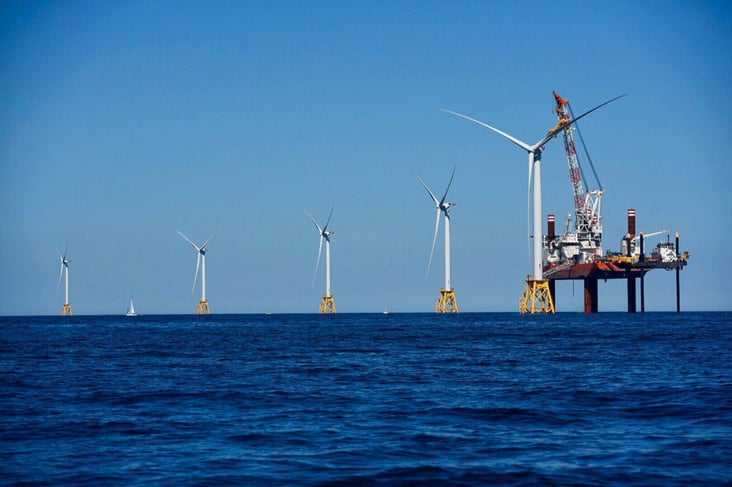This is a guest post by AEE Gold Affiliate member Mintz Levin.

Image of Block Island construction courtesy of Jeff Grybowski, originally posted to Twitter.
The United States will join Europe later this year when the nation’s first offshore wind farm becomes operational off Block Island, R.I. Deepwater Wind is bringing online the first offshore wind farm in domestic waters, a breakthrough for an industry that has worked for more than a decade to generate clean, reliable, cost effective energy, create good jobs, and strengthen local economies. Deepwater’s milestone project comes after the industry failed to move forward with the proposed 468 MW Cape Wind project off the coast of Cape Cod, after facing opposition from the fishing industry, American Indian groups, and property owners in the area for more than a decade. It also appears to be just the beginning of offshore wind development in the U.S.
The $300 million, five-turbine, 30 MW Block Island Wind Farm will begin commercial operation in early November, powering roughly 17,000 homes on the island. Deepwater also has additional, larger projects underway, though in earlier stages of development, one off Long Island and the other halfway between Montauk, N.Y., and Martha’s Vineyard, Mass. Compare this to Europe, where 3,344 offshore wind turbines currently provide nearly 12,000 MW to the grid.
The federal Bureau of Ocean Energy Management (BOEM) has awarded 11 commercial offshore wind energy leases for sites along the East Coast, and announced in June a proposal to hold a competitive lease sale for an area off the New York coast later this year. Developers are also requesting commercial wind leases for areas off the coasts of California and Hawaii. BOEM Director Abigail Ross Hopper anticipates that the industry will grow significantly in the next three to five years as projects begin to develop and become operational.
As states continue to adopt and work to meet ambitious renewable energy standards, offshore wind projects may increasingly fit into their plans. Two states recently took actions that could tremendously benefit the offshore wind industry. Massachusetts Gov. Charlie Baker signed an energy bill in August requiring utility companies to procure long-term contracts totaling at least 1,600 MW from offshore wind farm projects over the next 10 years. Around the same time, New York established a Clean Energy Standard that requires 50% of the state’s electricity to come from renewable energy sources by 2030, and the state Public Service Commission requested that the New York State Energy Research and Development Authority (NYSERDA) devise a mechanism to maximize the potential for offshore wind in the state.
At the national level, there is a push for federal legislation that would encourage the growth of the nascent domestic offshore wind industry, with Senators Tom Carper (D-DE), Susan Collins (R-ME), Ed Markey (D-MA), and Sheldon Whitehouse (D-RI), as well as Representatives Bill Pascrell (D-NJ) and Jim Langevin (D-RI), leading their colleagues in efforts to secure investment tax credits for the industry utilizing either MW- or date-based approaches. The negotiations at the end of last year ended in an extension of the ITC and PTC for solar and wind, but the phase-down of the ITC (which is generally seen as more valuable for capital-intensive offshore wind installations) by 2019 would provide little support for an industry just getting its start in the U.S. As a result, these lawmakers will be working with their colleagues to extend some form of ITC to the offshore wind industry as it develops.
Meanwhile, the Departments of Energy and Interior released earlier this month a National Offshore Wind Strategy in order to facilitate the responsible development of domestic offshore wind energy. The National Renewable Energy Laboratory has estimated that the United States has over 4,000 GW of offshore wind potential, enough to power the country four times over. Should the United States deploy 86 GW offshore wind by 2050, as DOE’s Wind Vision study describes, national benefits could include a 1.8% greenhouse gas reduction, saving $50 billion in avoided global damages; reduced water consumption; greater energy diversity and security; increased economic development and employment, including $440 million in annual lease payments into the U.S. Treasury and about $680 million in annual property tax payments, as well as 160,000 jobs in coastal regions and around the country. Furthermore, the offshore wind industry requires a local infrastructure, which could lead to significant jobs and economic growth.
All told, more than 300 local workers were involved with building the Block Island Wind Farm. Deepwater Wind used four Rhode Island ports – at Block Island, Galilee, Quonset Point and ProvPort – to complete construction and staging. The three developers holding leases off the Massachusetts coast – Deepwater, DONG Energy, and OffshoreMW – have committed to leasing the New Bedford Marine Commerce Terminal (originally developed by the state for use by Cape Wind) as their staging areas for those projects. The Wind Vision study scenario estimates that 32,000-34,000 offshore wind-related jobs around the United States could be created by 2020, increasing to 76,000-80,000 in 2030 and 170,000-181,000 by 2050. For context, the European offshore wind industry employed 75,000 workers by the end of 2014.
Currently, offshore wind components are manufactured in Europe, but as domestic U.S. demand grows, significant manufacturing benefits present themselves, as the manufacturing of turbines and the significant number of associated jobs develop in the United States as well. Developing an offshore wind industry right here in America will increase our nation’s competitiveness in energy sector, revitalize industrial ports, bolster the manufacturing sector, and create good, high paying, jobs in the years to come.